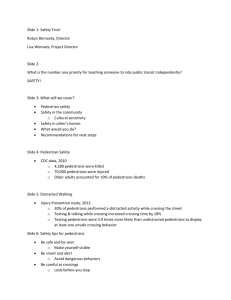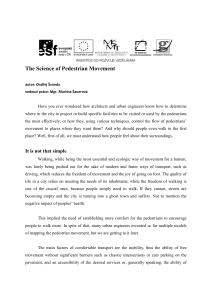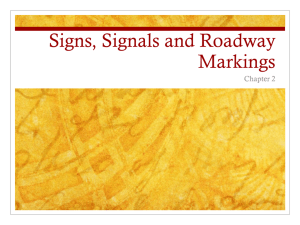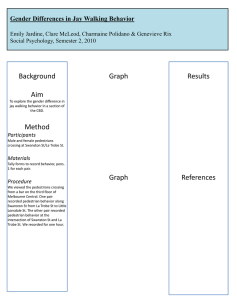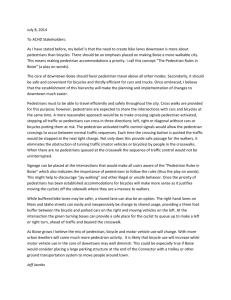Attach. No. 8 RW No.7 - National Committee on Uniform Traffic
advertisement
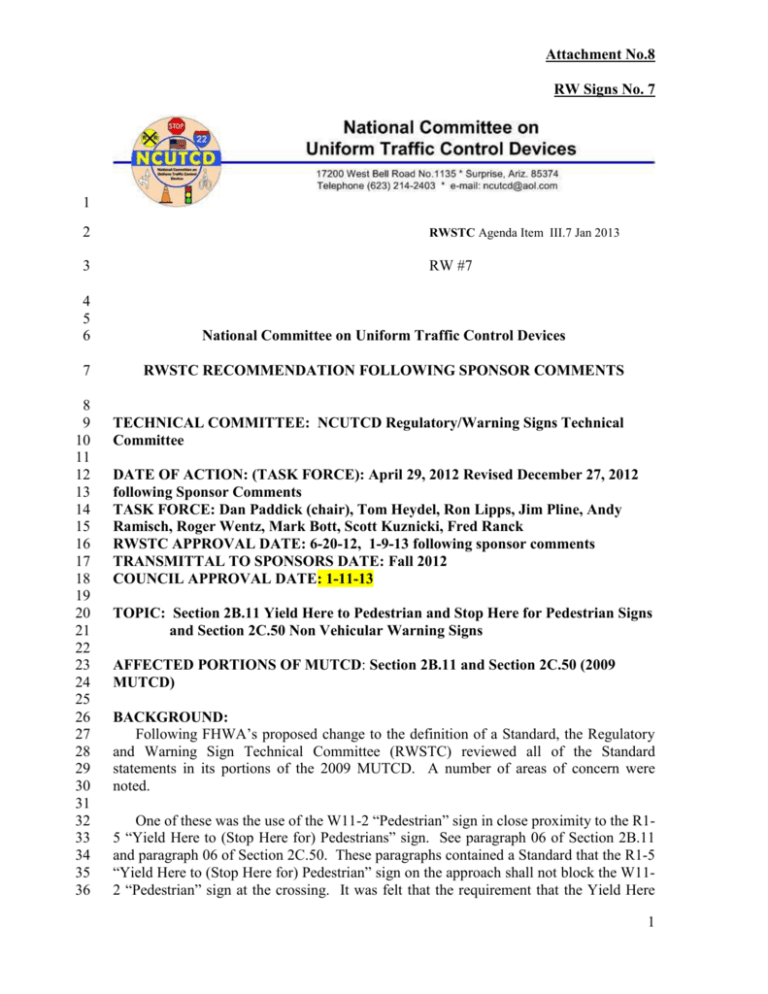
Attachment No.8 RW Signs No. 7 1 2 RWSTC Agenda Item III.7 Jan 2013 3 RW #7 4 5 6 National Committee on Uniform Traffic Control Devices 7 RWSTC RECOMMENDATION FOLLOWING SPONSOR COMMENTS 8 9 10 11 12 13 14 15 16 17 18 19 20 21 22 23 24 25 26 27 28 29 30 31 32 33 34 35 36 TECHNICAL COMMITTEE: NCUTCD Regulatory/Warning Signs Technical Committee DATE OF ACTION: (TASK FORCE): April 29, 2012 Revised December 27, 2012 following Sponsor Comments TASK FORCE: Dan Paddick (chair), Tom Heydel, Ron Lipps, Jim Pline, Andy Ramisch, Roger Wentz, Mark Bott, Scott Kuznicki, Fred Ranck RWSTC APPROVAL DATE: 6-20-12, 1-9-13 following sponsor comments TRANSMITTAL TO SPONSORS DATE: Fall 2012 COUNCIL APPROVAL DATE: 1-11-13 TOPIC: Section 2B.11 Yield Here to Pedestrian and Stop Here for Pedestrian Signs and Section 2C.50 Non Vehicular Warning Signs AFFECTED PORTIONS OF MUTCD: Section 2B.11 and Section 2C.50 (2009 MUTCD) BACKGROUND: Following FHWA’s proposed change to the definition of a Standard, the Regulatory and Warning Sign Technical Committee (RWSTC) reviewed all of the Standard statements in its portions of the 2009 MUTCD. A number of areas of concern were noted. One of these was the use of the W11-2 “Pedestrian” sign in close proximity to the R15 “Yield Here to (Stop Here for) Pedestrians” sign. See paragraph 06 of Section 2B.11 and paragraph 06 of Section 2C.50. These paragraphs contained a Standard that the R1-5 “Yield Here to (Stop Here for) Pedestrian” sign on the approach shall not block the W112 “Pedestrian” sign at the crossing. It was felt that the requirement that the Yield Here 1 Attachment No.8 RW Signs No. 7 37 38 39 40 41 To (Stop Here For) Pedestrians sign not block the road user’s view of the W11-2 sign should be a Guidance statement rather than a Standard statement because of the engineering judgment involved in determining whether a road user’s view of the sign is blocked. 42 DISCUSSION: 43 44 45 46 47 48 49 50 51 52 53 54 55 56 57 58 59 60 61 62 63 64 65 66 67 68 69 On January 24, 2011, the RWSTC amended paragraph 06 of Section 2B.11 by removing the phrase “…or block the road users view of the …” from the phrase “…shall not be placed on the same post or block the roadusers view of the W11-2 sign.” A guidance statement was then added that said “The Yield Here To (Stop Here For) Pedestrians” sign should not block the road user’s view of the W11-2 sign.” These changes were sent to Sponsors and approved by Council unanimously on June 24, 2011. 70 71 72 73 74 75 76 RECOMMENDATION: Section 2B.11 and Section 2C.50 should be consistent. In January 2012 the RWSTC addressed changing paragraph 06 of Section 2C.50 to match Paragraph 06 of Section 2B.11. Considerable discussion ensued. It was noted that paragraph 06(D) of Section 2A.16 Standardization of Location already contains a Guidance statement that recommends that signs “do not obscure each other.” Since the Standard was being changed to Guidance it was felt that the universal Guidance statement in Section 2A.16 was sufficient to address the situation. For reference purposes, paragraph 06 of Section 2A.16 states: 06 Signs should be located so that they: A. Are outside the clear zone unless placed on a breakaway or yielding support (see Section 2A.19), B. Optimize nighttime visibility, C. Minimize the effects of mud splatter and debris, D. Do not obscure each other, E. Do not obscure the sight distance to approaching vehicles on the major street for drivers who are stopped on minor-street approaches, and F. Are not hidden from view. Amend the Council approved version of Section 2B.11 to remove the new Guidance statement since it is already contained in Section 2A.16. Also amend paragraph 06 of Section 2C.50 to delete the phrase “…or block the road users view of…” from the last sentence of the paragraph since it is already contained in Section 2A.16. 2 Attachment No.8 RW Signs No. 7 77 78 Note: Proposed changes to the MUTCD are shown in underline red and removed text are shown in strikethrough red. 79 80 81 82 83 84 85 86 87 88 89 90 91 92 93 94 95 96 97 98 99 100 101 102 103 104 105 106 107 108 109 110 111 112 113 114 115 116 117 118 119 120 RECOMMENDED WORDING: Section 2A.16 Standardization of Location Support: 01 Standardization of position cannot always be attained in practice. Examples of heights and lateral locations of signs for typical installations are illustrated in Figure 2A-2, and examples of locations for some typical signs at intersections are illustrated in Figures 2A-3 and 2A-4. 02 Examples of advance signing on an intersection approach are illustrated in Figure 2A-4. Chapters 2B, 2C, and 2D contain provisions regarding the application of regulatory, warning, and guide signs, respectively. Standard: 03 Signs requiring separate decisions by the road user shall be spaced sufficiently far apart for the appropriate decisions to be made. One of the factors considered when determining the appropriate spacing shall be the posted or 85th-percentile speed. Guidance: 04 Signs should be located on the right-hand side of the roadway where they are easily recognized and understood by road users. Signs in other locations should be considered only as supplementary to signs in the normal locations, except as otherwise provided in this Manual. 05 Signs should be individually installed on separate posts or mountings except where: A. One sign supplements another; B. Route or directional signs are grouped to clarify information to motorists; C. Regulatory signs that do not conflict with each other are grouped, such as turn prohibition signs posted with one wa y signs or a parking regulation sign posted with a speed limit sign; or D. Street name signs are posted with a stop or yield sign. 06 Signs should be located so that they: A. Are outside the clear zone unless placed on a breakaway or yielding support (see B. Optimize nighttime visibility, C. Minimize the effects of mud splatter and debris, D. Do not obscure each other, E. Do not obscure the sight distance to approaching vehicles on the major street for drivers who are stopped on minor-street approaches, and F. Are not hidden from view. Support: 07 The clear zone is the total roadside border area, starting at the edge of the traveled way, available for use by errant vehicles. The width of the clear zone is dependent upon traffic 3 Attachment No.8 RW Signs No. 7 121 122 123 124 125 126 127 128 129 130 131 132 133 134 135 136 137 138 139 140 141 142 143 144 145 146 147 148 149 volumes, speeds, and roadside geometry. Additional information can be found in AASHTO’s “Roadside Design Guide” (see Section 1A.11). 150 151 Section 2B.11 Yield Here To Pedestrians Signs and Stop Here For Pedestrians Signs (R1-5 Series) 152 153 154 155 156 157 158 159 160 161 162 163 164 165 Standard: 01 Yield Here To (Stop Here For) Pedestrians (R1-5, R1-5a, R1-5b, or R1-5c) signs (see Figure 2B-2) shall be used if yield (stop) lines are used in advance of a marked crosswalk that crosses an uncontrolled multi-lane approach. The Stop Here for Pedestrians signs shall only be used where the law specifically requires that a driver must stop for a pedestrian in a crosswalk. The legend STATE LAW may be displayed at the top of the R1-5, R1-5a, R1-5b, and R1-5c signs, if applicable. Guidance: 08 With the increase in traffic volumes and the desire to provide road users regulatory, warning, and guidance information, an order of priority for sign installation should be established. Support: 09 An order of priority is especially critical where space is limited for sign installation and there is a demand for several different types of signs. Overloading road users with too much information is not desirable. Guidance: 10 Because regulatory and warning information is more critical to the road user than guidance information, regulatory and warning signing whose location is critical should be displayed rather than guide signing in cases where conflicts occur. Community wayfinding and acknowledgment guide signs should have a lower priority as to placement than other guide signs. Information of a less critical nature should be moved to less critical locations or omitted. Option: Under some circumstances, such as on curves to the right, signs may be placed on median islands or on the left-hand side of the road. A supplementary sign located on the left-hand side of the roadway may be used on a multi-lane road where traffic in a lane to the right might obstruct the view to the right. 11 Guidance: 12 In urban areas where crosswalks exist, signs should not be placed within 4 feet in advance of the crosswalk Guidance: 02 If yield (stop) lines and Yield Here To (Stop Here For) Pedestrians signs are used in advance of a crosswalk that crosses an uncontrolled multi-lane approach, they should be placed 20 to 50 feet in advance of the nearest crosswalk line (see Section 3B.16 and Figure 3B-17), and parking should be prohibited in the area between the yield (stop) line and the crosswalk. 4 Attachment No.8 RW Signs No. 7 166 167 168 169 170 171 172 173 174 175 176 177 178 179 180 181 182 183 184 185 186 03 Yield (stop) lines and Yield Here To (Stop Here For) Pedestrians signs should not be used in advance of crosswalks that cross an approach to or departure from a roundabout. Option: 04 Yield Here To (Stop Here For) Pedestrians signs may be used in advance of a crosswalk that crosses an uncontrolled multi-lane approach to indicate to road users where to yield (stop) even if yield (stop) lines are not used. 05 A Pedestrian Crossing (W11-2) warning sign may be placed overhead or may be post-mounted with a diagonal downward pointing arrow (W16-7P) plaque at the crosswalk location where Yield Here To (Stop Here For) Pedestrians signs have been installed in advance of the crosswalk. Standard: 06 If a W11-2 sign has been post-mounted at the crosswalk location where a Yield Here To (Stop Here For) Pedestrians sign is used on the approach, the Yield Here To (Stop Here For) Pedestrians sign shall not be placed on the same post as or block the road user’s view of the W11-2 sign. 187 RECOMMENDED WORDING: 188 189 190 191 192 193 194 195 196 197 198 199 200 201 202 203 204 205 206 207 06 If a W11-2 sign has been post-mounted at the crosswalk location where a Yield Here To (Stop Here For) Pedestrians sign is used on the approach, the Yield Here To (Stop Here For) Pedestrians sign shall not be placed on the same post as or block the road user’s view of the W11-2 sign. The above shown in red was deleted by Council June 2011 and Council approved the following Guidance Statement. Guidance: The Yield Here To (Stop Here For) Pedestrians sign should not block the road user’s view of the W11-2 sign. We are now deleting the above guidance statement as it is redundant with Section 2A.16 which already states that signs should be located so as not to obscure each other. Option: 07 An advance Pedestrian Crossing (W11-2) warning sign with an AHEAD or a distance supplemental plaque may be used in conjunction with a Yield Here To (Stop Here For) Pedestrians sign on the approach to the same crosswalk. 5 Attachment No.8 RW Signs No. 7 208 209 08 In-Street Pedestrian Crossing signs and Yield Here To (Stop Here For) Pedestrians signs may be used together at the same crosswalk. 210 211 212 213 214 215 216 217 218 219 220 221 222 223 224 225 226 227 228 229 230 231 232 233 234 235 236 237 238 239 240 241 242 243 244 245 246 247 248 Section 2C.50 Non-Vehicular Warning Signs (W11-2, W11-3, W11-4, W11-6, W11-7, W11-9, and W11-16 through W11-22) Option: 01 Non-Vehicular Warning (W11-2, W11-3, W11-4, W11-6, W11-7, W11-9, and W1116 through W11-22) signs (see Figure 2C-11) may be used to alert road users in advance of locations where unexpected entries into the roadway might occur or where shared use of the roadway by pedestrians, animals, or equestrians might occur. Support: 02 These conflicts might be relatively confined, or might occur randomly over a segment of roadway. Guidance: 03 If used in advance of a pedestrian, snowmobile, or equestrian crossing, the W11-2, W11-6, W11-7, and W11-9 signs should be supplemented with plaques (see Section 2C.55) with the legend AHEAD or XX FEET to inform road users that they are approaching a point where crossing activity might occur. Standard: 04 If a post-mounted W11-2, W11-6, W11-7, or W11-9 sign is placed at the location of the crossing point where pedestrians, snowmobilers, or equestrians might be crossing the roadway, a diagonal downward pointing arrow (W16-7P) plaque (see Figure 2C-12) shall be mounted below the sign. If the W11-2, W11-6, W11-7, or W11-9 sign is mounted overhead, the W16-7P plaque shall not be used. Option: 05 A Pedestrian Crossing (W11-2) sign may be placed overhead or may be post-mounted with a diagonal downward pointing arrow (W16-7P) plaque at the crosswalk location where Yield Here To (Stop Here For) Pedestrians signs (see Section 2B.11) have been installed in advance of the crosswalk. Standard: 06 If a W11-2 sign has been post-mounted at the crosswalk location where a Yield Here To (Stop Here For) Pedestrians sign is used on the approach, the Yield Here To (Stop Here For) Pedestrians sign shall not be placed on the same post as or block the road user’s view of the W11-2 sign. Option: 6 Attachment No.8 RW Signs No. 7 249 250 251 252 253 254 255 256 257 258 259 260 261 262 263 264 265 266 267 268 269 270 271 272 273 07 An advance Pedestrian Crossing (W11-2) sign with an AHEAD or a distance supplemental plaque may be used in conjunction with a Yield Here To (Stop Here For) Pedestrians sign on the approach to the same crosswalk. 08 The crossing location identified by a W11-2, W11-6, W11-7, or W11-9 sign may be defined with crosswalk markings (see Section 3B.18). 09 The W11-2 and W11-9 signs and their related supplemental plaques may have a fluorescent yellow-green background with a black legend and border. Guidance: 10 When a fluorescent yellow-green background is used, a systematic approach featuring one background color within a zone or area should be used. The mixing of standard yellow and fluorescent yellow-green backgrounds within a selected site area should be avoided. Option: 11 A Warning Beacon (see Section 4L.03) may be used with any Non-Vehicular Warning sign to indicate specific periods when the condition or activity is present or is likely to be present, or to provide enhanced sign conspicuity. 12 A supplemental WHEN FLASHING (W16-13P) plaque (see Figure 2C-12) may be used with any Non-Vehicular Warning sign that is supplemented with a Warning Beacon to indicate specific periods when the condition or activity is present or is likely to be present. 274 275 276 277 278 279 280 281 282 283 284 285 286 287 288 289 RWSTC VOTE 6-20-12: For: Unanimous Opposed: Abstentions: RWSTC VOTE 1-9-13 For: 26 Opposed: 0 Abstentions: 1 COUNCIL VOTE: 1-11-13 For: Unanimous C:NCUTCD/January 2013/RW # 7 Section 2B.11 and 2C.50 Yield Here to Peds, STOP here for Peds approved following sponsor comments by RWSTC 1-9-13 approved by Council 1-11-13 7
